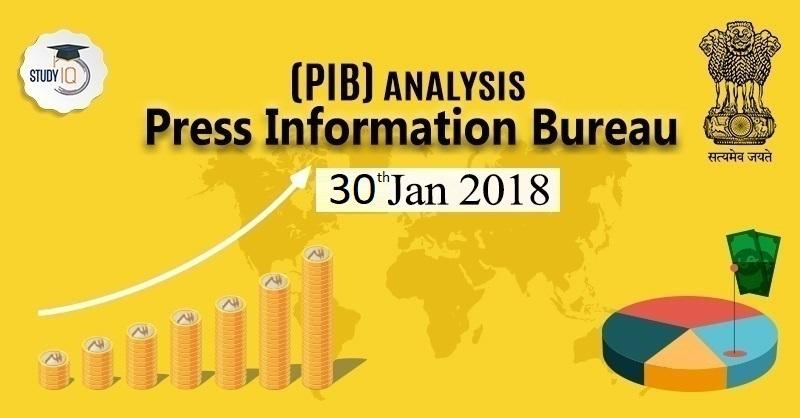Table of Contents
Download Free PDF – Daily PIB analysis
Farmers’ Welfare and Agriculture
• The highlight of the Economic Survey: economic growth is expected to gain momentum in 2018-19 after two years of deceleration.
• Survey forecast that the economy will grow at a pace of 7-7.5% next year as against 6.75% in the current year.
• High frequency indicators such as vehicle sales and industrial output: shock imparted on account of demonetisation and transition to Goods and Services Tax (GST) has worn off.
• Agriculture, which employs 49% of the workforce while making up just 16% of the economy, is in trouble.
Main Exam Important Topic: Farmers’ Welfare and Agriculture
• Age-old challenge of low productivity + climate change
• The outcome will be a loss of income in agriculture, particularly for poorer farmers without
the cushion of irrigation.
• Governments at all levels are aware of challenges ahead and there have been haphazard attempts to solve them.
• More coherent approach is required which fits into the overall reform package that brings in more scientific methods into agriculture.
• Farm distress is likely to be one of the major focal points of the upcoming Union Budget.
Farmers’ Welfare and Agriculture
• Agri-GDP growth has fallen to around 2 per cent per annum in the first four years of the Modi government; the real incomes of farmers have fallen as well.
• Growth in the agriculture sector is much b
• It is a price deficiency payment (PDP) scheme, being undertaken by the government of Madhya Pradesh.
• BBY applies to eight kharif crops — soybean, maize, urad, tur, moong, groundnut, til, ramtil.
• The Haryana government has announced a somewhat similar scheme for four vegetables — potatoes, onions, tomatoes and cauliflower.
• Farmers have to first register on a portal.
• Their sown area is verified by government officials.
• They are then asked to bring their produce to mandis at a time fixed by the state government
Bhavantar Bhugtan Yojana (BBY)-
• Based on average productivity of a crop in the district and area cultivated by the farmer, the quantity of each produce that is eligible for deficiency payment is also determined by the government.
• Farmers receive the difference between average sale price (ASP) and MSP directly into their bank accounts.
• The ASP is calculated as the simple average of the weighted modal prices of the relevant crops in the regulated mandis of Madhya Pradesh and two adjoining states.
• The price information is drawn from the Centre’s agmarknet.gov.in portal.
• The scheme seems interesting as it provides an alternative to physical
procurement of commodities at minimum support prices (MSPs).
–
• For kharif 2017-18, so far, data related to five crops (soybean, maize, groundnut, urad and moong) has been finalised for price deficiency payment.
• The market prices of til and ramtil are higher than the MSP and therefore they do not qualify for price deficiency payment.
• The tur season will start from February.
Results

• Key results of BBY for October-December, 2017.
• It is interesting to note that only 32 per cent of urad production in Madhya Pradesh got the yojana’s benefit despite the fact that ASP of urad was 42 per cent below its MSP.
• In other words, 68 per cent of urad production was sold at prices below MSP, without any compensation under BBY.
• In the case of soybean, the state’s prime kharif crop, the percentage of production benefiting from this scheme is even lower — only 18.5 per cent, despite its ASP being 12 per cent below the MSP.
• And for maize, groundnut and moong, the coverage is even poorer
What the graph displays?
• The Madhya Pradesh government claims to have paid about Rs 1,900 crore as compensation to farmers for these five crops.
• But that pertains to only those farmers registered on its portal. A larger proportion of farmers are not registered on the portal and they have been selling their produce at huge losses. These farmers have not received any compensation.
• In fact, those not registered under BBY have to suffer bigger losses because traders are suppressing the market.
• Haryana’s scheme for four vegetables is even worse as the presumed MSP (Rs 400 per quintal for potatoes and tomatoes and Rs 500 per quintal for onions and cauliflower) does not even cover the full cost of production as estimated by the Union Ministry of Agriculture and the National Horticulture Board for these crops.
• Announced in the second week of January, the scheme’s objective is to
relieve farmers from taking loans from moneylenders by giving them Rs
4,000 per acre for the kharif and rabi seasons.
• It is envisaged that the farmer will use this money for purchase of inputs
ranging from seeds to fertilisers to machinery and hired labour.
• The area eligible for investment support is 14.21 million acre — the
government’s annual bill for the project, thus, comes to around Rs 5,685 crore.
• The Telangana model does not require the farmer to register his cultivated area and crops.
Telangana’s input support scheme
• The farmer is free to grow a crop of his choice and sell it anytime in a mandi of his choice.
• This model is crop-neutral, more equitable, more transparent, and gives farmers the freedom to choose.
• Incidentally, China has a similar scheme: It gives aggregate input subsidy support on a per acre basis.
• The scheme does not distort markets and is worth following.





















 WhatsApp
WhatsApp